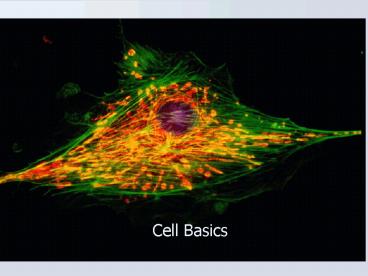Cell Basics - PowerPoint PPT Presentation
1 / 31
Title:
Cell Basics
Description:
Cell Basics Introduction to Cells A. Cells are the basic units of organisms B. Cells can only be observed under a microscope C. Basic types of cells: Prokaryotes ... – PowerPoint PPT presentation
Number of Views:237
Avg rating:3.0/5.0
Title: Cell Basics
1
Cell Basics
2
Introduction to Cells
- A. Cells are the basic units of organisms
- B. Cells can only be observed under a microscope
- C. Basic types of cells
3.Bacterial Cell
1.Animal Cell
2.Plant Cell
3
(No Transcript)
4
(No Transcript)
5
- D. Organisms may be
- Unicellular composed of one cell
- Multicellular- composed of many cells that may
organize
6
- E. Cells may prokaryotic or eukaryotic
- Prokaryotes include bacteria lack a nucleus or
membrane-bound structures called organelles - Eukaryotes include most other cells have a
nucleus and membrane-bound organelles (plants,
fungi, animals)
7
Prokaryotes
- Nucleoid region contains the DNA
- Cell membrane cell wall
- Contain ribosomes (no membrane) to make proteins
in their cytoplasm
8
Eukaryotic Cell
- Contain 3 basic cell structures
- Nucleus
- Cell Membrane
- Cytoplasm with organelles
9
F. Organelles
- Very small size
- Can only be observed under a microscope
- Have specific functions
- Found throughout cytoplasm
10
G. Cell or Plasma Membrane
Cell membrane
- Living layer
- Controls the movement of materials into and out
of the cell - Selectively permeable
- Made of phospholipids and proteins
11
H. Cytoplasm of a Cell
- Jelly-like substance enclosed by cell membrane
- Provides a medium for chemical reactions to take
place - Contains organelles to carry out specific jobs
12
I. Nucleus
- Controls the normal
activities of the cell - Bounded by a
nuclear membrane - Contains chromosomes
13
J. Plant Cell Organelles
- Contain the green pigment chlorophyll
- Traps sunlight to make to make sugars (food)
- Process called photosynthesis
14
Cell wall
- Dead layer
- Made of cellulose which forms very thin fibers
- Give shape to the cell
- Strong and rigid
15
Different kinds of plant cells
16
K. Animal cell
cytoplasm
vacuole
- No cell wall or chloroplast
- Stores glycogen in the cytoplasm for food energy
nucleus
mitochondrion
cell membrane
glycogen granule
17
Different kinds of animal cells
18
L. Differences between plant cells and animal
cells
Animal cells
Plant cells
Relatively smaller in size
Relatively larger in size
Irregular shape
Regular shape
No cell wall
Cell wall present
19
Differences between Plant Cells and Animal Cells
Animal cells
Plant cells
Vacuole small or absent
Large central vacuole
Glycogen as food storage
Starch as food storage
Nucleus at the center
Nucleus near cell wall
20
Differences between Plant Cells and Animal Cells
Animal cells
Plant cells
Lysosome present
No lysosome
No chloroplasts
Chloroplasts present
21
M. Levels of organization
- Cells are grouped together and work as a whole to
perform special functions
22
Tissue
- A group of similar cells to perform a particular
function - Animals epithelial tissue, muscular tissue
- Plants vascular tissue, mesophyll
23
Organ
- Different tissues group together to carry out
specialized functions - Heart consists of muscles, nervous tissue and
blood vessels - Leaf consists of epidermis, mesophyll and
vascular tissue
24
The Structures of a Leaf (Plant Organ)
Chloroplast
Palisade Mesophyll Cell
Spongy Mesophyll Cell
Air Space
Stoma
25
The Structures of a Heart (Animal Organ)
26
System
- Several organs and tissues work together to carry
out a particular set of functions in a
co-ordinated way - Human digestive, respiratory, excretory,
circulatory and reproductive systems - Plant root and shoot systems
27
Human Body Systems
- Examples of systems
- Digestive System
- Respiratory System
- Circulatory System
- Nervous System
- Reproductive System
28
Examples of a Human Body System
29
Levels of Organization
- CELLS (muscle cells,nerve cells)
- TISSUES (muscle, epithelium)
- ORGANS (heart, lungs, stomach)
- SYSTEMS (circulatory system)
- ORGANISM (human)
30
Its You!
31
CELL TRIVIA- SMALLEST -mycoplasmas (.1 -
.3 microns)- LARGEST -ostrich egg-
LONGEST - nerve cells (up to 3 feet!)- HUMAN
CELLS 1. SMALLEST - sperm 2. LARGEST -
egg

